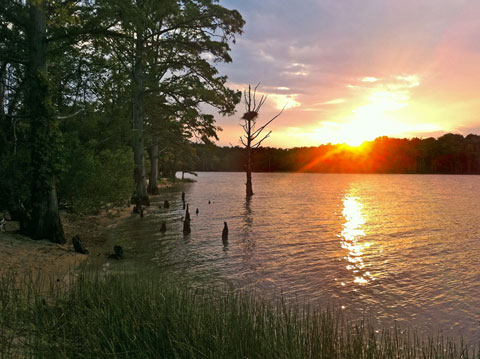
The James River near Surry — © Brian Rose
Taken with my iPhone. We found this spot a mile or two down a dirt road near the James River ferry. Back to New York today.
A song I wrote years ago:
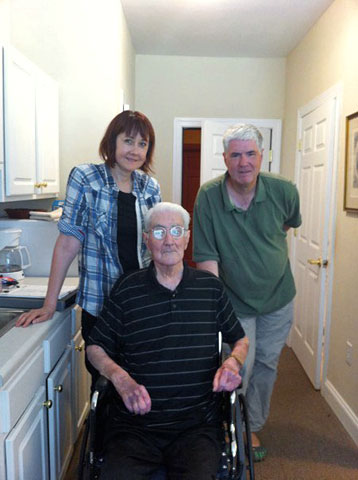
My sister, father, and me one week ago in Williamsburg.
It has been a roller coaster of a weekend for me. Saturday, a story and interview about my photos of the World Trade Center ran on the homepage of CNN. Today, I rushed down to Virginia after receiving a phone call informing me that my 90 year old father was rapidly slipping away. I arrived too late. He died this afternoon before I got there.
The photo above was taken a week ago. After an extended stay in the hospital and in rehab, my father had come back home to his assisted living apartment. It was a short-lived, but triumphant return. He was happy to be with friends and in familiar surroundings. My sister and I wheeled him around the building greeting residents along the way, and we sat with him in the dining room accompanied by his table buddies. It appeared, fleetingly, that he might resume a measure of his former routine. But it was not to be.
This morning, an article and podcast interview about my photographs of the World Trade Center is featured on the front page of CNN.com. Be sure to listen to the podcast, which is down on the left side of the page.
Article, photos, and interview can be found here.
West 36th Street — © Brian Rose
Stan Banos at Reciprocity Failure asks “Are you a street photographer?” and points to my recent photograph of balloons as evidence that it is still possible to find moments of wonder ” in the street.” People suggest that street photography is making a comeback.
Maybe I’m out of touch with the current chatter, but it’s not something I’ve thought about lately. I guess there was a time as a student when I thought of myself as a street photographer. And it’s true that I still make a lot of photographs while perambulating about the city. But it seems to me that street photography refers more to a style of picture taking than to the simple act of making photographs in public places.
Sometimes I work with a 4×5 view camera, especially engaged in long term projects, and sometimes a pocket size digital camera. The photograph above was made with a Canon 5D with a tilt/shift lens employed while doing an architectural shoot. I find images where I am–the street or otherwise.
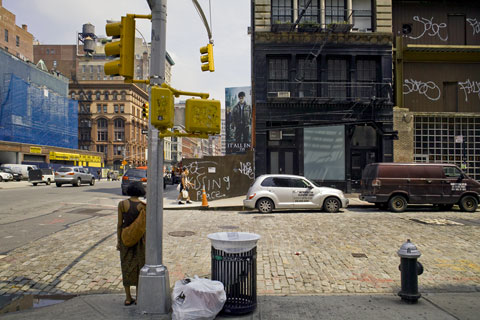
Bond and Lafayette Streets — © Brian Rose
In the grip of a debt crisis brought on by Tea Party economic terrorism, New York appears placid at the start of the weekend–on the surface. One imagines the agitated garden party conversations out in the Hamptons among the captains of finance. How did the good faith and credit of the United States come to be held hostage by an ignorant rabble? The mind boggles. We all await Monday and the morning bell.
I will be teaching a class this fall at ICP focused on photographing the Lower East Side of Manhattan. Each student will pick a subject, theme, or geographical area–I plan to shoot the Bowery with a 4×5 camera–and then we will design and print a book of the images using Blurb. This will be the coolest class ever. Go here for a pdf of the entire brochure. Below is a clipping:
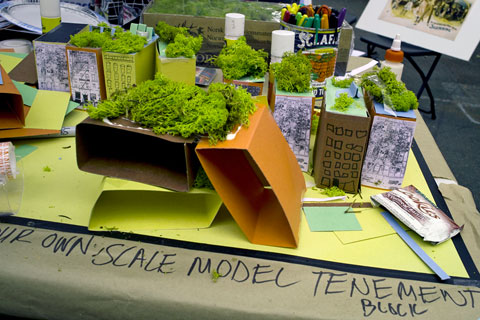
Sarah D. Roosevelt Park — © Brian Rose
We visited the New Museum block party in Sarah Roosevelt park yesterday–despite the continuing heat. While I talked to David Mulkins, the director of the Bowery Alliance of Neighbors, an organization trying to save the historical character of the Bowery, Brendan, my son, busied himself creating a model tenement out of colored paper. His design is probably not what the preservationists had in mind–but I like it a lot.
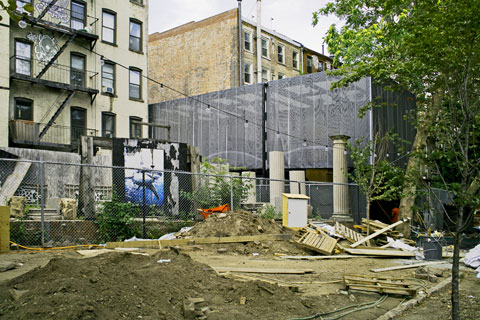
BMW Guggenheim Lab — © Brian Rose
A few blocks north I snapped a few pictures of another example of cutting edge Lower East Side architecture, the BMW Guggenheim Lab, a temporary structure to serve as a sort of interactive urban think tank. Exactly how it will function–besides being a cool object–I am not sure. Designed by Atelier Bow-Wow of Tokyo, the structure is described as a tool box from which things can be raised or lowered to the ground level.
I like the way the structure is inserted into a gap between a row of tenements creating a passage linking E1st and Houston Street. I’ve photographed this gap and adjacent open space before–one image is in my book Time and Space on the Lower East Side.
Which brings me to my book. I have decided to work with a small New York publisher with the intention of bringing out Time and Space on the Lower East Side by the end of the year. I will provide more details later, once the deal is finalized, but I am confident that this will be a beautiful and successful book. It will require money, however, and I am planning to make use of Kickstarter, a web based fund raising platform for creative projects. I will, of course, let everyone know when the campaign is launched.
In the meantime, the current Blurb version of Time and Space remains available–but not for long. Once the new book is set into motion, the Blurb book will be withdrawn, never to appear again. Book collectors take note. The St. Mark’s Bookshop has a few signed copies.
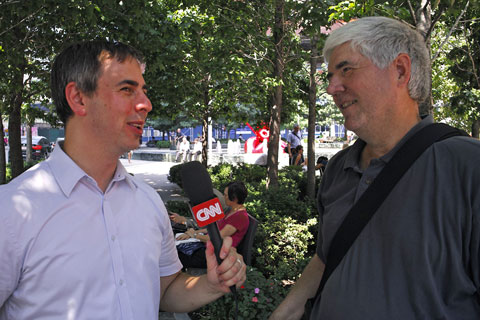
Steve Katzenbaum of CNN radio and Brian Rose
Yesterday I was interviewed by CNN radio for a piece they are doing about the loss of the Twin Towers on the city’s skyline and about the rapidly rising 1 WTC tower, which is intended to replace, visually and symbolically, the iconic presence of the former skyscrapers. I brought my WTC book with me, and talked about some of the pictures and answered questions from CNN correspondent Steve Katzenbaum.
We met in the small triangular park at Greenwich Street and Vesey Street just below 1 WTC. The tower appears about 2/3 of the way up. It’s a busy spot with commuters coming to and from the PATH station while gawking tourists and hard hatted construction workers commingle.
I don’t yet have a time and date for the broadcast, which I believe will be available as a podcast on the CNN website.
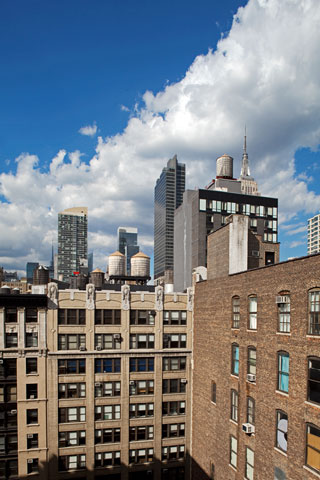
From E25th Street — © Brian Rose
Finished several photo shoots and then got out of town to join up with former members of the Colonial Williamsburg Fifes and Drums performing at the annual Deep River muster in Connecticut. Some of us have a hard time keeping up our musical chops and remembering all the tunes, but we have enough who can still play admirably. Our sound remains unmistakable, famous within the fife and drum world.
Here we are on Main Street in Deep River:
We stopped at this spot on Main Street to duplicate a photograph taken of the corps back in the early 1960s, before my time. I joined in 1964. The photographer gestures for the banner holders (one of whom is my son Brendan) to move forward out of the shot.
Although we continue to perform music from the 18th century in an authentic style, that’s as far as it goes. No tri-cornered hats, knee breeches or buckled shoes. In fact, three of us marched sans shoes. I’m the tall one. From there we marched to Devitt Field where we opened the afternoon’s stand performances by playing the National Anthem. The present Colonial Williamsburg Fifes and Drums does perform in full costume.
Back in New York on Sunday I replaced my dead Sigma DP1 camera with the newer DP1x. It’s not a perfect camera, but it produces astounding quality for something that fits in a pocket. Ability to shoot RAW files and a large sensor make the DP1 special. Sometimes sensor size is more important than megapixels. That’s the case with this camera.
I spent the day in East New York photographing a new low income apartment building. It’s in a neighborhood of single family homes and other new apartment buildings. The big housing blocks that East New York is known for are some distance away. Not that many years ago, this area would have had a blown apart look with lots of vacant lots and abandonment. Things have changed substantially, but it is still a rough edged place. A glimpse of my project can be seen at far right above.
Across the street there was a large truck and bus repair shop and a woodworking shop. On the adjacent corner a used car dealer and seller of gravestones. Nearby, is a large “transit technology” school.
During the day, the area exhibits a fairly relaxed atmosphere, but the conspicuous use of window gates, fences, and other security measures, suggests a different aspect. And indeed, after dark the area showed a more menacing face. My assistant and I arrived by subway, carrying a camera case and small lighting kit, but chose to take a car service back. Nevertheless, with every new project of the kind I was photographing, the neighborhood becomes more stable and livable.
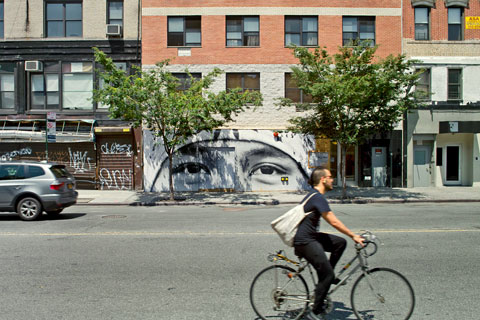
JR image on Essex Street — © Brian Rose
Go here for more JR in New York.
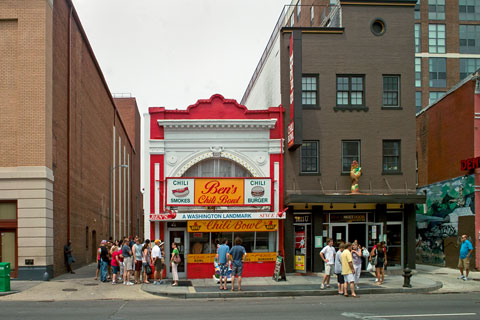
Ben’s Chili Bowl on U Street, Washington, D.C. — © Brian Rose
I stayed in Washington with my family at a hotel on Dupont Circle. We walked up 18th Street through Adam’s Morgan, an ethnically diverse area I lived in briefly in the ’70s. Afterward, Brendan, my 12 year old son, insisted that we return to Ben’s Chili Bowl, a Washington icon that he and I visited a couple of years ago. This being the 4th of July, a line of tourists formed in the adjacent alley.
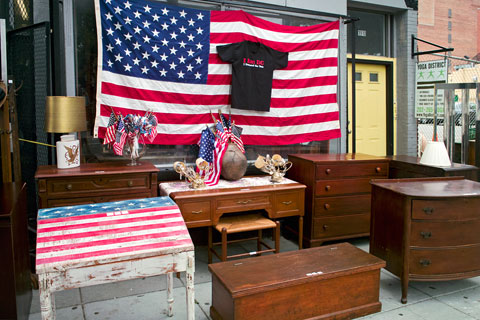
14th and T, Washington, D.C. — © Brian Rose
From Ben’s we walked down to the intersection of 14th Street and T, a corner mentioned in my song Open All Night. Today, the area has greatly gentrified–a sidewalk cafe and a high end furniture store occupy two corners. But the other corners remain partially empty and somewhat bedraggled. So, despite the upscale incursions, 14th Street still feels like it’s on the edge between one thing and another–which in D.C. usually means between white and black. The t-shirt above says I Am DC, I Demand the Vote, a reference to the fact that citizens of the District of Columbia are not represented in Congress, an inexcusable disenfranchisement of approximately 602,000 people.
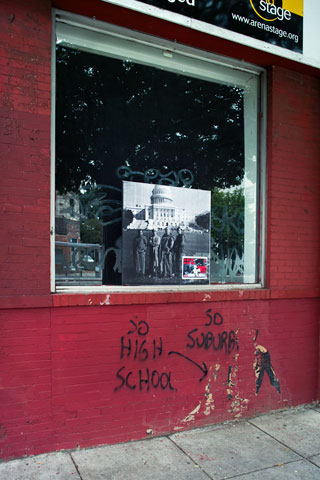
14th and T, Washington, D.C. — © Brian Rose
Open All Night
Smoke blue breath in the window
Harsh lights and watery eyes
Burnt out butt out and out of sight
The deal goes down at moonrise
A newspaper blows through this tunnel of love
A tumbleweed in the city blight
Pissing neon in the pouring rain
Open all night
Skin green splitting in the back room
Still praying to God above
Dim names left back in the diner
All for a thimble full of love
There’s news of a murder up at 14th and T
And the waitress shivers with fright
As two cops tell a fish story
Open all night
She wipes the counter and she sweeps the floor
She makes the coffee and she asks do you want some more
She looks in the eyes of a desperate man
She can’t say much but she can understand
Another aimless loner
Another brittle voice
Another ghostly goner
His head in his hands
Open all night
And outside the street is a minefield
To the ex-soldier with the tattooed arm
A cigarette stuck on his lower lip
He thinks of his mom back on the farm
And thick thighs snicker behind him
She says boy you don’t have to fight
Come on home with me baby
I’m open all night
(© Brian Rose)
***
Here is my song:
***
Although I’m proud of my version of the song, go here for Lucy Kaplansky’s stunning performance.
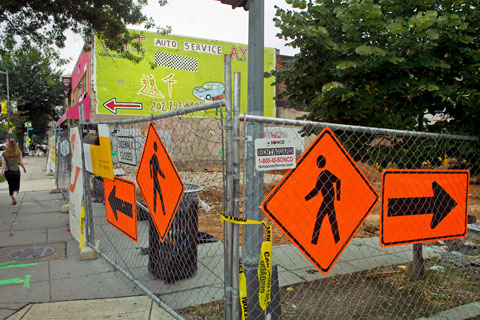
14th and R, Washington, D.C. — © Brian Rose
From 14th and T we walked back to Dupont Circle, and ended the day watching the fireworks on the Mall.